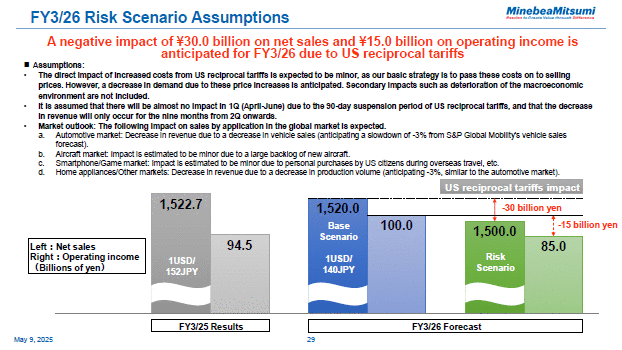Presentation Transcripts
Latest Update : May 28, 2025
Back to Financial Results (FY3/2025)
Presentation for FY 3/2025 held on May 9, 2025
- Cover
- Today's Agenda
- Financial Results Overview and Forecast
- Summary of Consolidated Financial Results for the Fiscal Year
- Summary of Consolidated Financial Results for 4Q
- Net Sales, Operating Income, and Operating Income Margin
- Quarterly Trends: Net Sales, Operating Income, and Operating Income Margin
- 4Q Results: Variance from Previous Forecast (Announced February 5, 2025)
- Precision Technologies Segment (PT)
- Quarterly Trends: Precision Technologies Segment (PT)
- Motor, Lighting & Sensing Segment (MLS)
- Quarterly Trends: Motor, Lighting & Sensing Segment (MLS)
- Semiconductor & Electronics Segment (SE)
- Quarterly Trends: Semiconductor & Electronics Segment (SE)
- Access Solutions Segment (AS)
- Quarterly Trends: Access Solutions Segment (AS)
- Profit Attributable to Owners of the Parent / EPS
- Quarterly Profit Attributable to Owners of the Parent / EPS
- Inventories
- Net Interest-Bearing Debt and Free Cash Flow
- Earnings Forecast for FY3/26
- Segment Changes
- Earnings Forecast for FY3/26 by Segment (Base Scenario)
- Earnings Forecast for FY3/26 by Segment (Risk Scenario)
- Management Policy & Business Strategy
- FY3/25 Highlights
- FY3/26 Earnings Forecast (Base Scenario)
- ① Impact of US Reciprocal Tariffs
- FY3/26 Risk Scenario Assumptions
- Net Sales and Operating Income Forecast for FY3/26 (by Segment)
- ② Plans for the FY3/26
- Long-Term Trend in Net Sales and Operating Income
- Precision Technologies Segment (PT) Outlook
- Motor, Lighting & Sensing Segment (MLS) Outlook
- Semiconductor & Electronics Segment (SE) Outlook
- Access Solutions Segment (AS) Outlook
- ③ M&A Deal
- Commencement of Tender Offer of Shares of SHIBAURA ELECTRONICS CO., LTD.
- Significance of Business Integration with SHIBAURA ELECTRONICS [1/2]
- Significance of Business Integration with SHIBAURA ELECTRONICS [2/2]
- Our M&A Principles
- ④ Initiatives for Medium- to Long term Growth
- Integration of the Core Businesses
- Products Supporting the Future World [1/2]
- Products Supporting the Future World [2/2]
- Robot Hand Development Project in Progress
- Products for Solving Social Issues
- ESG (Environment)
- ⑤ Shareholder Returns
- Dividends
- Forward-looking Statements
- Reference
Let me talk about the impact of the U.S. reciprocal tariffs, which I know is of great interest to you. I believe that we can assume many different theories, but based on my 17 years of managing our company, we have faced many unexpected events. Even so, I do not believe that we have strayed far from our expectations by much.
This time, the idea was first divided largely by whether the subject product is portable or not. In other words, if it is portable, for example, when you travel, in the U.S., you can import things up to $800 tax free and up to $1,000 with a 3% duty. The taxes paid at the airport are minimal, and we believe that portable products will be brought back to the U.S. through various channels, much like the Chinese buying spree that was once a hot topic in Japan for a while. The problem is with non-portable products. We believe that large products such as automobiles, airplanes, and home appliances should be considered with caution.
Our top priority is to eliminate concerns related to the tariff impact on aircraft. Because, right now, Boeing has an order backlog of about 6,300 aircrafts, of which 160 are backlogged that China has refused or will refuse to take delivery of. There are backlog of over 6,000 aircraft, and we have not received any requests from the customer to slow down. Airbus likewise has a backlog of 8,726 aircraft, of which 902 are destined for the U.S., accounting for approximately 10%. Therefore, if you disregard the aircraft, I think the issue will still be automobiles and large home appliances. A month ago, S&P Global Mobility announced that global demand for automobiles would be down 1.8% due to the U.S. reciprocal tariffs, and we took this data and stressed it a bit more, assuming -3% for automobiles and -3% for large home appliances.
There is no slowdown at all in the 1Q, and so far we expect April, May, and June to be in line with expectations; multiplying by three-quarters for the 2Q-4Q and subtracting marginal profit and others, we calculate a risk scenario of about 85 billion yen in operating income for the full year. We calculate the operating income of base scenario to be about 100 billion yen, taking into account the impact of foreign exchange rates, and the risk scenario factors in the possibility of a decrease in operating income of about 15 billion yen. We disclosed our earnings forecast in a range at the time of COVID-19, and we announce our earnings forecast in a range again this time because of the uncertainty of the roadmap for resolving the U.S. reciprocal tariff issue.
29page (total 65pages)
![]() You need Adobe Reader® to view these documents. Click on Adobe Reader icon on the left to download the software from the Adobe Systems website.
You need Adobe Reader® to view these documents. Click on Adobe Reader icon on the left to download the software from the Adobe Systems website.
It ends about main text.












